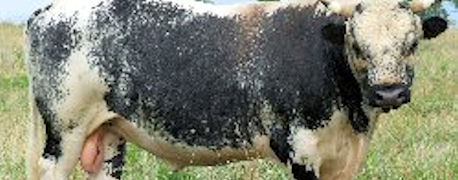
Beef producers bough some of the best genetics in the Northeast during a bull sale at Pennsylvania's Livestock Evaluation Center in Pennsylvania Furnace, Centre County, on March 29. This marked their 40th annual performance-tested bull sale.
(Originally posted: July 24, 2008) Ask any cattleman what breed produces the best beef, and he'll pridefully point – without hesitation – to his own animals. But what if you put the same question to food industry professionals – chefs, marketers and connoisseurs?
That's exactly what happened last month at Ayrshire Farm, outside of Upperville, Va. About 70 food professionals were rounded up for a blind-tasting test to compare beef from eight rare heritage breeds and two widely available breeds of cattle.
The event was hosted by a partnership of the American Livestock Breeds Conservancy, Humane Farm Animal Care, Slow Food USA and Ayrshire Farm. Its mission was to show the culinary diversity of the 10 breeds and the value of conserving rare breeds.
"We have to eat them to save them," says Sandy Lerner, host for the tasting. "When we eat them, we're giving farmers an economic reason to conserve rare breeds and the important genetic diversity they represent."
Chuck-section meat from each breed was roasted without spices, and cut into bite-sized pieces in covered dishes at numbered stations. The meat was scored based on flavor, texture, tenderness, smell and appearance.
So which breed bested the 'fork test'?
Breeds put to the "fork test" were: Ancient White Park, Angus, Dexter, Galloway, Highland, Milking Devon, Pineywoods, Randall Lineback, Red Poll, and (beef) Shorthorn. Here's how they ranked by first-place votes:
•Randall Line back: 19 votes.
•Galloway: 11 votes.
•Dexter: 10 votes.
•Highland: 6 votes.
•Red Poll: 5 votes.
•Angus: 5 votes.
•White Park: 3 votes.
•Shorthorn: 3 votes.
•Milking Devon and Pineywoods: 0 votes.
The Randall Line back, native to New England, the Galloway and the Dexter chewed up nearly as many first place votes as any of the other breeds tasted. While steers from seven breeds were finished on organic feed at Ayrshire Farm, three were not.
The Red Poll and Milking Devon were finished on grass. The Randall Lineback was grown and conventionally finished on Chapel Hill Farm, Berryville, Va.
To quote one attendee, Lina Burton of The Mercer House, "And the beef, who would have thought that they really did taste different. [They] were so much better than what's available commercially in the supermarket?"
For more about the beef breeds, placings, hosting organizations and cattle facts, visit: www.ayrshirefarm.com/tasting/beef.
About the Author(s)
You May Also Like




